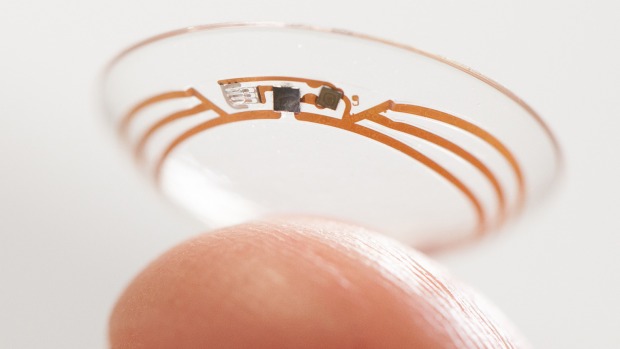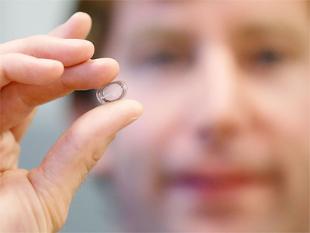The year 2014 with regards to wearable technology and wearable devices has kicked off in style as we’ve seen a lot of manufacturers either showcase or launch their respective wearable devices. If you thought that was the future of consumer electronics and wearable technology, think again because the folks at Google X have just taken the game one step forward. In a statement released during the latter part of last week, Google (NASDAQ : GOOG) has stated that it is developing a contact lens that will monitor the blood-sugar levels of the wearer through his/her tears.
What you just read may seem to be straight out of a Sci-Fi movie’s script but this is not Sci-Fi. This is the real deal. Google X is the in-house R&D centre for developing future technologies. Google X labs have been notorious for developments such as a driverless car, Project Loon (a network of balloons intended for beaming internet waves to the far reaching areas), Google Glass, etc. in the past and now they’ve just announced this special kind of lens.
The Google smart lens cannot be counted in the ranks of other wearable devices that are primarily meant for tasks such as receiving notifications, viewing messages and the like. This device will try to address one of the most pre-dominant lifestyle diseases of our times – diabetes. The big news with respect to these smart lenses is that they can relay information about one’s glucose levels in real time, thereby eliminating the constant pricks and jabs of those painful needles needed to monitor blood glucose levels.
While the actual consumer ready device might take as many as five years from now to translate in to reality, the current prototype glucose monitoring smart lens, in terms of physical structure is just like any other soft contact lens but here is where the similarities end. It houses an embedded sensor unit between two layers of lenses that measure the glucose levels through the tears. There is a tiny, pinhole sized passage in the lens that lets tear fluid seep over into the glucose monitoring sensor unit. This unit features a tiny antenna, capacitor and a controller.
At present, it can monitor the glucose levels once every second but the scientists at Google are developing a variant that will be more efficient than this prototype version. This miniature sensor also has a wireless transmitter that will relay the data collected from your eyes to a nearby handheld device to display this information. The sensor unit in the lens will be powered by this device and will communicate with that particular device through the RFID (Radio-Frequency Identification) technology. As a safety measure, it also houses a circuit breaker to prevent it from heating.
“Over the years, many scientists have investigated various body fluids—such as tears—in the hopes of finding an easier way for people to track their glucose levels. But as you can imagine, tears are hard to collect and study. At Google[x], we wondered if miniaturized electronics—think: chips and sensors so small they look like bits of glitter and an antenna thinner than a human hair—might be a way to crack the mystery of tear glucose and measure it with greater accuracy.” – Brian Otis, Project Co-founder.
The developers at Google have also mentioned that they’re working on incorporating a system wherein this device will be able to warn its user in case there is a change in insulin levels beyond the values which have been pre-set by him/her. They’re trying to integrate tiny LED lights that can light-up at such eventualities.
While this may seem to be a relieving piece of information for the average diabetic struggling out there with his/her glucose monitoring device, there are still quite a number of issues that need to be addressed in connection to this device.
- The smart lens will be channelizing sensitive and medical data about its user and in this day and age when there are a number of apps and devices that collect data for various ‘development’ processes, it remains to be seen how Google can help safeguard this data from such data capturing entities. The response comes from Joseph Lorenzo Hall, chief technician at the Centre for Democracy and Technology who states, “The data will never hit Google servers.”
- The practicality and adaptability of this device is also in question. One begins to wonder how one could compare information derived from blood samples to that from tears. Another burning question that might be on many people’s minds is how exactly this device will perform when there is excessive secretion of tears (while chopping onions, when in an emotional or deeply moving situation, when your eyes are exposed to gushing winds). Some may wonder if the smart lens could possibly hamper vision. Potential users may also be wary of any hidden side effects associated with the prolonged use of these lenses.
Although these lenses have been developed during the last eighteen months, this concept isn’t entirely new. In 2001, the FDA (US Food and Drug Administration) approved of a wristwatch glucose monitor but sadly, that device didn’t do too well due to technical glitches. In fact, the chief scientists (Brian Otis and Babak Parvis) on this project were earlier associated with Microsoft for a similar project. Microsoft affirmed this by releasing a statement stating the same kind of developmental work being done a few years ago.
At the same time, other devices of similar nature that monitor glucose related data through non-needle technology are also being developed. There is the Israeli OrSense that has tested a thumb-cuff and is also planning to test various tattoo and saliva sensors and NovioSense from Netherlands which is a flexible spring like device that has to be tucked under the eyelid.
At present there are about 382 million people affected with diabetes and this figure will reach 592 million by the year 2035. A major chunk of the world’s diabetics (read 80%) live in the low and middle-income earning countries. According to Renub Research, the market for glucose monitoring devices is expected to cross the $16 billion mark by the end of this year. These figures should be motivation enough for the scientists at Google X labs to develop and ensure that Google’s glucose monitoring smart lenses make it to mass production and consumption stage at the earliest and therein lies their (the scientists and developers at Google) actual challenge.



